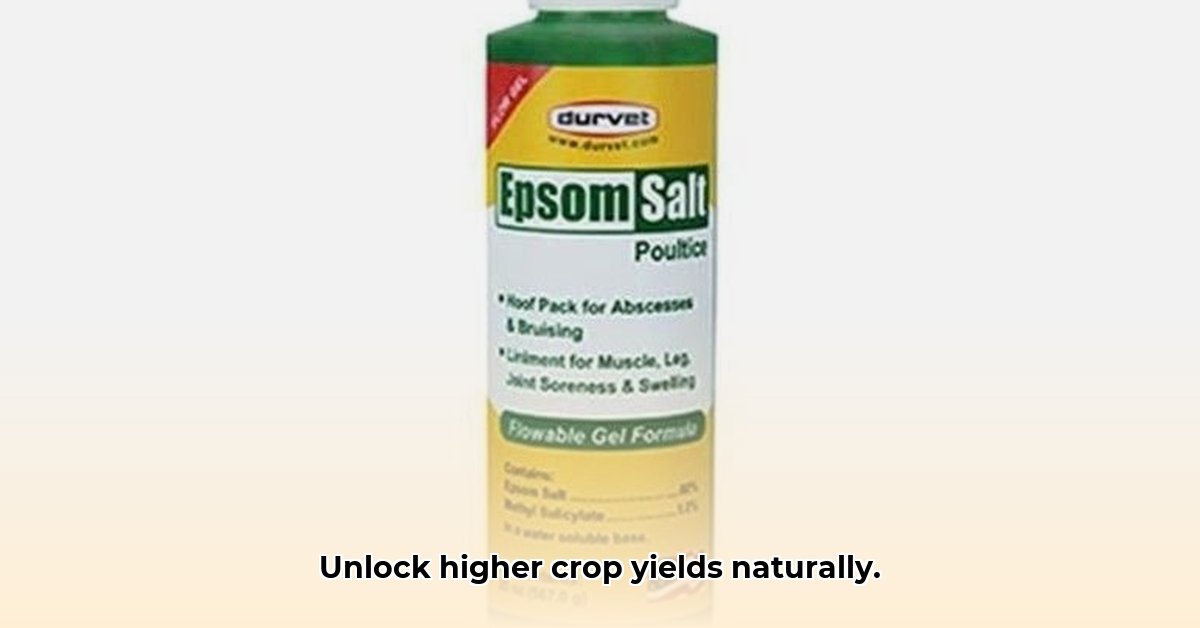
Understanding Epsom Salt's Role in Sustainable Agriculture
Epsom salt (magnesium sulfate) offers a readily available and affordable way to supplement magnesium and sulfur in your soil. These nutrients are vital for plant health, playing crucial roles in photosynthesis and overall plant vigor. But, like any soil amendment, Epsom salt requires careful consideration to avoid potential drawbacks. This guide provides actionable steps for effective and responsible use. Are you ready to optimize your yields while maintaining soil health? For efficient soil preparation, consider using soil tilling equipment.
Magnesium: The Plant's Energy Catalyst
Magnesium is a key component of chlorophyll, the molecule responsible for photosynthesis – the process by which plants convert sunlight into energy. Insufficient magnesium leads to chlorosis (yellowing of leaves), stunted growth, and reduced yields. Epsom salt provides a direct and easily absorbed source of this essential nutrient. A lack of magnesium is akin to running a car without sufficient fuel. It simply won't perform optimally.
Epsom Salt: Advantages and Cautions
Epsom salt is a natural, environmentally friendly alternative to some synthetic fertilizers. It is widely available and inexpensive, making it an accessible option for farmers of all sizes. However, overuse can lead to soil salinity, harming plants and impacting long-term soil health. Therefore, careful application is paramount. Will your crops benefit from this readily-available supplement, or will it cause more harm than good?
A Step-by-Step Guide to Epsom Salt Application
Before applying Epsom salt, remember that a balanced approach is key. Overapplication can be detrimental. Think of it as a carefully-measured ingredient in a recipe for soil health.
Step 1: Conduct a Comprehensive Soil Test. This foundational step reveals your soil's nutrient levels, including magnesium and sulfur. Knowing your soil's current composition prevents unnecessary applications and potential imbalances. A soil test provides the crucial baseline data to guide your actions. Consider contacting your local agricultural extension office for guidance on soil testing.
Step 2: Calculate the Appropriate Dosage. The required amount of Epsom salt depends on factors such as soil type, crop type, and the results of your soil test. Online resources and agricultural extension offices often provide guidelines for application rates tailored to specific plant requirements. Start with a conservative amount as a test, always aiming for less rather than excess.
Step 3: Strategically Apply Epsom Salt to your Soil. 1. Direct Soil Application: Incorporate Epsom salt into the soil before planting or early in the growing season. This ensures the nutrients are available as the plant develops. 2. Foliar Spray: For plants already showing signs of magnesium deficiency, a foliar spray provides a rapid boost. Dissolve Epsom salt in water according to package instructions and gently spray your plants.
Always refer to the specific instructions provided on your Epsom salt packaging. Careful reading is crucial to prevent unintended consequences.
Step 4: Monitor Plant Response and Adapt Accordingly. Observe how your plants respond to the Epsom salt application. Are they greener, healthier, and growing more vigorously? Your plants are the ultimate indicator. Adjust your application rate or method for subsequent applications based on your observations. Remember: consistent monitoring leads to optimized results.
Step 5: Integrate Epsom Salt into a Broader Sustainable Strategy. Epsom salt alone is not sufficient to support optimal soil health. Pair it with other sustainable practices like composting, cover cropping, and crop rotation for a more holistic approach. It's one piece of the puzzle, not the entire picture.
Potential Benefits and Drawbacks of Epsom Salt Usage
Advantages:
- Enhanced Plant Health: Increased magnesium levels lead to improved chlorophyll production, resulting in healthier, more vibrant plants.
- Improved Yields: Healthier plants generally translate to increased harvests, with larger fruits, vegetables, and overall greater abundance.
- Enhanced Nutrient Uptake: Magnesium aids in the uptake of other essential nutrients, promoting more comprehensive plant nourishment.
- Stress Tolerance: Improves resilience to environmental stressors such as drought, disease, and nutrient deficiencies.
- Economic Advantage: Epsom salt is often more cost-effective than similar synthetic magnesium fertilizers.
Drawbacks:
- Soil Salinity: Overuse can lead to salt buildup, potentially harming plant growth.
- Nutrient Imbalances: Excessive magnesium can disrupt the delicate balance of other essential nutrients.
- Leaching: Excessive watering can wash away Epsom salt before plants absorb the nutrients.
- Not a Complete Fertilizer: Epsom salt only provides magnesium and sulfur; plants still require other vital nutrients.
Dr. Emily Carter, Soil Scientist at the University of California, Davis, states: "While Epsom salt offers a readily available source of magnesium, responsible application through soil testing and careful monitoring is crucial to prevent soil salinity and maintain long-term soil health."
Minimizing Soil Salinity: Best Practices
To mitigate the risk of soil salinity, follow these key strategies:
- Regular Soil Testing: This is the cornerstone of responsible Epsom salt application. It helps determine if magnesium supplementation is necessary and guides appropriate application rates.
- Appropriate Water Management: Efficient irrigation techniques and avoiding overwatering prevent leaching and salt accumulation.
- Soil Amendments: Incorporating organic matter, like compost, improves soil structure and drainage, reducing salinity risks.
- Salt-Tolerant Crop Selection: Opting for crop varieties with high tolerance to salinity further reduces the negative impact.
- Leaching Techniques: If salinity is already present, carefully planned leaching can flush excess salts from the soil.
By implementing these strategies, you contribute to a thriving ecosystem while maximizing agricultural productivity.
Conclusion: A Balanced Approach to Sustainable Farming
Epsom salt can be a valuable tool in sustainable agriculture when used judiciously. Understanding its benefits and potential drawbacks, combined with responsible application methods and a commitment to soil health monitoring, allows for successful integration into a holistic farming system. Remember, effective farming is about balance and continuous learning—always adapt and refine your techniques for optimal yield and sustainable growth.